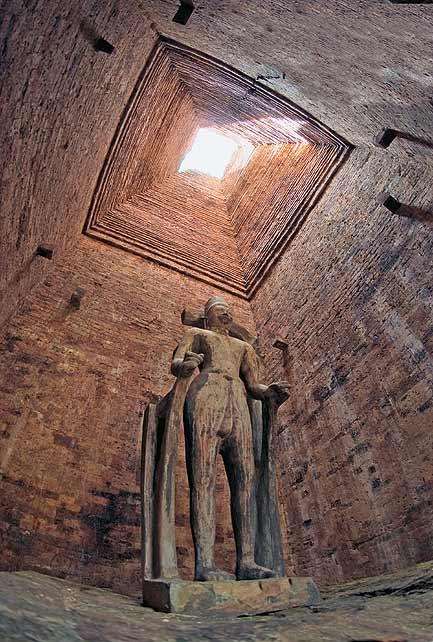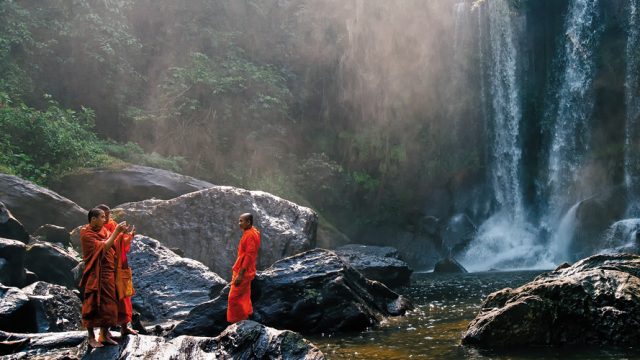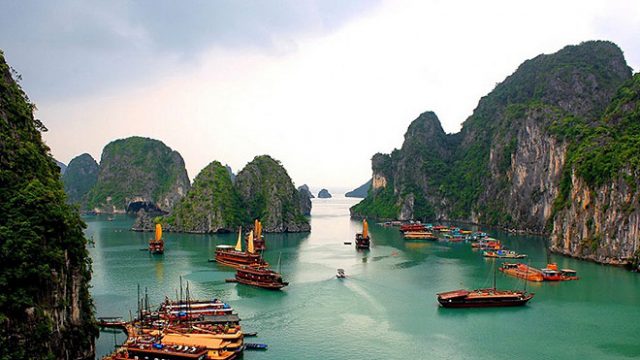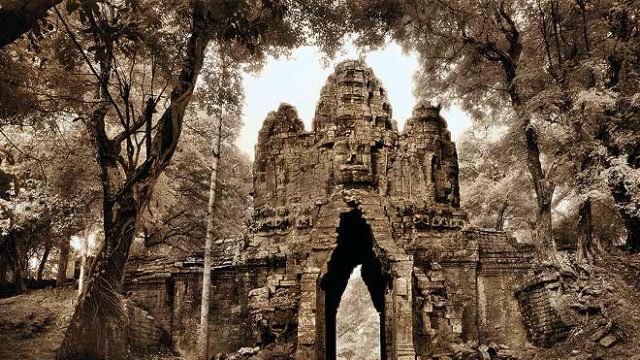1. Island in the Rain – Phnom da
Steep steps rise from dense vegetation to this imperious prasat
Getting there: The happening NH2 connects Phnom Penh all the way to Angkor Borei. Phnom Da lies 3km to the south of Angkor Borei and is reached via Takéo town, which is only 78km on flat, mostly tarred and sometimes dirt roads from the well-infrastructured capital, doable as a pleasantly full day trip in a little under two hours each way. That’s in dry weather. The roads are far more difficult to negotiate when it rains and may force an overnight stay in the rudimentary lodges of Takéo. If you do summon the courage for it, ask for the spartan but reliable and friendly Meas Family Homestay (cambodianhomestay.com), a good place to break the southward journey to Phnom Bayong (next page). It’s also possible, and far more memorable, to park at the Takéo dock and switch to individual, shared or larger motor boats to reach Angkor Borei (40 mins) and Phnom Da (another 15) over the ancient waterway — in the rains, the boat ride under grey skies over a sea-like floodplain marked by floating clumps of grass and drowned trees is surreally something else.
2. Such solitude – Phnom Bayong
It takes a three-hour hike to reach Bayong Koa and Ta Nhean, both pre-Angkorian sites at the crest of this border hill (there’s also a vertiginous staircase to be surmounted at the top) and there’s usually no one around to tell what is which — this further explains the blessed absence of chattering hordes and the presence of a large population of bats and butterflies. The climb itself is frequently under the shade of massive banyan trees, and rewarded by sweeping vistas of the Mekong floodplain below; the mountains of Vietnam loom over the painterly horizon. No treasure other than the experience itself awaits modern travellers to this summit of solitary ruins.
Getting there: Continue another couple of hours down NH2, close to the border of Vietnam and near the village of Kiri Vong. Since stay and food aren’t comfy hereabouts, this could be a separate if arduous day trip from Phnom Penh, for the climbing would make it still longer and more tiring.
3. Easy does it – Phnom Chisor
This temple, on the other hand, is more Angkorian than many (except for its location) — it belongs to the same era, was built by the Angkorian potentate Suryavarman I, it is still regal, appropriately sprawling, visually well-endowed (especially when compared with other lesser-known temples) and quite accessible despite some steepish climbing on a monumental staircase, whereupon there are elegant terraces and richly-embellished reliefs to be enjoyed minus hecklers or hordes. If you have the entire day to spare, spend it clambering down to the smaller shrines over the hillside, taking in the views leisurely.
Getting there: Less than 50km or an hour from Phnom Penh (tuk tuk rides may appear charming but will be dustier and nearly three times slower).
4. Kali is here – Prasat Neang Khmau
This neglected gem features a rare and fantastically well-preserved sandstone lintel of Viswakarma. The temple, as its name suggests, is dedicated to Neang Khmau or the ‘Black Virgin’, also the Khmer name for Kali, and has been left with only two crumbling towers instead of the original four (or five). It’s easy to imagine the rest in such an atmospheric site.
Getting there: 3km from Phnom Chisor and therefore an easy sidelight from it.
5. Lakeside reverie – Ta Prohm
The ruins of Ta Prohm, not to be confused with Siem Reap’s Ta Prohm, are lovelier still, and their tranquil location by the Tonlé Bati lake has something to do with it. Even if it is combined on the same-day trip as Phnom Chisor, as it often is, it’s possible to meditate over treasures like the grandly rendered lintels of the churning of the cosmic ocean (depicted twice here), something that may not be possible at the more famous version in Angkor Wat.
Getting there: Just about 30km from the madding clutter of Phnom Penh.
6. Halfway there – Sambor Prei Kruk
The 100-odd temples of this lost complex are not only pre-Angkorian but also the earliest recorded Khmer shrines. Historically Isanapura, the Chenla capital under the seventh century reign of Isanavarman, the ruins of this ancient centre of learning have been studied extensively although only three temple complexes have survived the ravages of time: Prasat Sambor is dedicated to Gambhireshvara, an incarnation of Shiva; the bewitching Yeay Peau is overrun by tree roots instead of other mortals; and the largest Prasat Tao, or the Lion Temple, gets its name from a pair of hulking stone lions.
Getting there: The Sambor Prei Kuk dots shady forests that are roughly 40km away on a bumpy road north of Kampong Thom in central Cambodia, roughly midpoint from Siem Reap to Phnom Penh, both about three hours each way and best reached by hiring cabs.
7. Sacred city – The Wats of Phonm Penh
Phnom Penh’s own charming wats also deserve mini-detours. If you have time for just two, the first would have to be the frequently missed Wat Ounalom right next door to the Royal Palace in the Cambodian capital. Its interiors are richly done up and surprisingly cool. Head upstairs for a nice view of, and breeze from, the Tonlé Sap river. Phnom Wat, on the other hand, is a bustling Buddhist shrine, decidedly more popular with locals and tourists alike, as good for people watching as it is for its paintings and stunning stupa, one of the finest in Asia.
Location Phnom Penh city
8. Fighting fit – Preah Vihear
Pavements and staircases link the stunningly well-preserved ninth century Preah Vihear, a Unesco World Heritage Site situated in a province of the same name, about 210km but a continent away from Angkor Wat. Preah Vihear is widely accepted as one of the finest examples of Khmer architecture and despite being nurtured by successive kings who lavished it with patronage in varying styles, it remains unusual for its layout along an 800-metre north-south axis, differing significantly from the east-facing rectangles seen everywhere else. What’s less peaceable is the century-old protracted dispute over its ownership fought by Cambodia and Thailand, both claiming its territory in the Dangrek mountains, a natural boundary dividing the two nations. Although the International Court of Justice awarded the treasures of Preah Vihear to Cambodia in 1962 by some accounts, Thailand was preparing for a national broadcast of another hearing at the ICJ in mid-April as we went to press. Certainly, gaining entry from Thailand used to be easier, enabled by better roads and visa-free access but the Thai-Cambodian border was sealed off in 2010 and remains contentious. Fortunately, the route from Siem Reap to Preah Vihear via Anlong Veng (210km) is now entirely paved.
Getting there: Leave early in the morning and return late in the evening — the journey takes over three hours from Siem Reap. The final, steep ascent is in a 4WD (a walk on the same road will take two hours).
9. By the way – Beng Mealea and Koh Ker
A haunting site of densely vegetated intrigue is Beng Mealea (‘lotus pond’ in Khmer), just over an hour away from Siem Reap, where sandstone remnants of Hindu temples also feature Buddhist motifs in some places. Just another 90 minutes away is all that’s left of the once glorious ninth century capital of the Khmer empire, now seen as the ruins of Koh Ker, a sprawl of several well-preserved temples spread over a largish area, most grandly visible in the seven-tiered Prasat Thom and its moat. Both sites will benefit from a good pair of tromping shoes. Also, don’t forget to lug your camera for some of the most captivating tree-in-temple shots in Cambodia.
Getting there: Beng Mealea is 70km from Siem Reap whereas Koh Ker is 120km down the same route. Both deserve an unhurried day by themselves but they are often not even included on the journey back from Prasat Preah Vihear, on the good and well-travelled road to which they conveniently fall. Siem Reap has efficient tour operators who arrange all-inclusive itineraries to all three sites in a one long day.
10. Fullsome adventure – Banteay Chhmar
Sometimes described as the ‘next Angkor Wat’, this beautiful complex is too isolated and difficult to reach to get anywhere that famous in the near future, which can’t be such a bad thing. The site for an experiment in community based tourism, it’s impossible not to be moved by the thickly forested and oddly fragile beauty of Banteay Chhmar, rich as it is with crumbling temples, haunting sculptures, and bas-reliefs of historic battles and apsaras, sometimes viewed by scrambling over fallen images of Hindu and Buddhist deities. Angkor Wat must have been discovered like this. It’s all very Indiana Jones-y.
Getting there: 100km/three-and-a-half hours from Siem Reap; only private cabs ply the dreadful roads on this route, and there’s a particularly bone-rattling last stretch from Sisophone. Some travellers claim to combine it with Preah Vihear, Koh Ker and Beng Mealea, which means you couldn’t do reasonably well, leave alone justly, by any of them. Set aside a day instead.
What to see and do in Cambodia
Leave a Reply
You must be logged in to post a comment.





